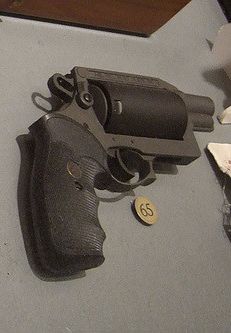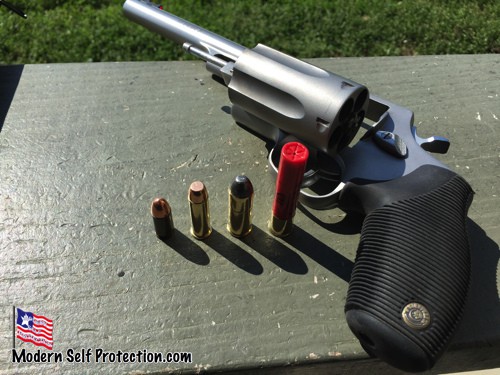Which came first, the Governor or the Judge? Well, in regards to those two particular guns, the Taurus Judge actually came out before the higher priced, big brand name Smith and Wesson jumped on the bandwagon with their version known as the Governor.
Most people are oblivious to that fact and incorrectly believe that the Governor came out first since it’s a Smith and Wesson and that the Judge, being merely a Taurus, was copied from it.
Well, they have been misled (or just didn’t bother to research it), but here’s another bit of information that people are likely unaware of. Taurus wasn’t the first to come out with this style of handgun either.
Whatever you might think about Taurus, you have to hand it to them on this front as they are responsible for opening, or rather reopening, the modern market on large frame revolvers chambering .410 shotshells.
But that’s beside the point. What you, me and every other shooter wants to know is which one of these pocket-sized scatterguns is worth your hard-earned money.
Does either have a significant advantage over the other, or intangibles that make one a better choice for a discerning shooter? We will answer those questions and more in the remainder of this article.

First! MIL inc. Thunder five
That distinction goes to MIL Inc.’s Thunder five, the first .410 shot shell revolver. But due to poor marketing strategies and the unwillingness of the American public to accept a heavy, clumsy, pocket shotgun, sales were low and the gun was discontinued after only six short years of manufacturing.
That’s not even mentioning that it really wasn’t a very attractive piece in the first place. One of the lures to draw people in to buy a handgun is the sleek lines and graceful curves that just say hold me. Well, the thunder five didn’t really have any of those attributes.
It was mostly just a big ugly chunk of metal that held five .410 shot shells as an oddity or five .45 long colt cartridges if you wanted to lay a whump on someone.
The problem is that if you want to fire a .45 Long Colt at someone, this wasn’t the best tool for doing so as it has about two full inches of jump before the bullet even hits the barrel.
A long bullet jump like that is generally not conducive to accuracy, in other words it’s a big belly gun (a belly gun is what you call a gun that is useless for anything more than jabbing it in some ones belly and pulling the trigger due to poor accuracy). The gun was manufactured from 1992 until 1998 but just never seemed to catch on.
In 1994 they came out with a version chambered in .45/70 government for a California legal version as the .410 shot shell version was illegal in California. I’d wager it was exactly the same gun and they just marked it “.45/70 Government”.
I would like to have a handgun that fired .45/70 Government if it was a fully rifled and accurate weapon with a five or six inch barrel. That would be neat.
Between generally rough workmanship, the aforementioned poor marketing and a gun that was generally seen as a novelty or a “solution looking for a problem” the thunder five has been relegated to nothing more than a curio in the list of domestic American firearms.
And that’s at best, with a fantastically overpowered and impractical .45-70 version being, charitably, a novelty and nothing more.
That being said the concept of the gun had enough sway that it was revisited some years later by Taurus who succeeded, commercially, where MIL Inc. had tried and failed.
Here comes the Judge
Eight years after the MIL Inc. Thunder five stopped production, in 2006 Taurus comes onto the scene with their Judge and suddenly all eyes were on the “new” .410 revolver on the market.

Granted, it is a much better looking piece of hardware than the Thunder five. You might say you get a lot of bang for your buck (Sorry, I couldn’t help myself).
Available in a lustrous blue finished steel or full stainless steel construction, The Judge, I suppose, makes a handy defense weapon for the blind, the incredibly shaky (remember Don Knots in the shakiest gun in the west?), or those that encounter a lot of snakes. No, seriously, it does make a great snake gun.
Besides those three reasons I think there are countless numbers of much better pieces to choose from for a self defense weapon. However I think the novelty of being a shot gun pistol alone combined with a very accessible price, is reason enough to add two to the Zombie arsenal. Sometimes it just doesn’t matter if the gun is practical when it just neat.
Bottom line, the Judge line of pistols quickly became a hit, and in the years since they have sold a literal boatload of them to considerable fanfare and even some paid critical acclaim.
These guns have gone on to be something of a staple product for Taurus, even though quality concerns have plagued them throughout the production run. The guns are notorious for heavy, rough triggers and, mechanically, typically live up to Taurus usual middling or spotty quality control.
In my experience with these guns one should expect breakages or defects to surface after a comparatively small number of rounds, particularly if they are fed a steady diet of a full power .45 Colt.
This might be a trifling concern for most owners, because they will not shoot them often enough with those loads to be an issue, but even when firing relatively sedate .410 shotshells it will not be too long before timing issues surface.
The concept is popular, no doubt about it, but Taurus is always up for the challenge of poorly executing on a concept no matter how good it might be.
Despite some quality issues, the Judge has proven popular enough to warrant dozens of variants and iterations over the years, and whether you want a long barrel or short, a bright finish or a more discreet one, metal frame or polymer, there is a Judge out there for you.
We will examine the conceptual usefulness of these guns in more detail later, but for now, let us move on to its closest competitor, the Governor, as made by Smith & Wesson.
Jerry Miculek shooting the Judge and Governor:
Copy Gat or Superior Model?
Then along came Smith and Wesson in 2011 with their double priced version of the pocket shotgun. No advances on the design except for the addition of one more chamber in the cylinder and maybe some fancier sights.
And a seemingly “exotic” metal construction, Scandium Alloy, which isn’t really all that exotic actually.
So for the die-hard Smith and Wesson fan you can purchase their version of the .410 pocket shotgun for merely about the cost of two of the Taurus’ offerings of stainless steel, which is a much more durable and reliable material in my opinion.
Though some might balk at the price increase attendant with the use of scandium in the construction of the frame, there is much to recommend it when strength and lightweight are desired. Note that the concept of a “scandium frame” is something of a misnomer.
The frame is made from scandium alloy, yes, but the predominant component in scandium alloy is typically aluminum. Though aluminum alloy, especially when used in the construction of firearms, is far from uncommon the addition of scandium kicks things up a notch.
The unique properties of scandium means that a tiny bit can be added to aluminum to form an alloy that is far stronger and lighter than typical alloys in the category.
Put another way, you can use less aluminum to achieve a threshold of strength than you would normally so long as it has that little bit of scandium in it. Scandium, as it happens, is extremely rare and that is why it is so expensive.
This, naturally, cranks up the cost of the Governor compared to the Judge but you are also paying for typical Smith & Wesson quality in components, assembly and quality assurance in the bargain.
For the ultimate in strength and weight savings, the scandium alloy-framed Governor makes a lot of sense but you’re going to pay for it. However, so long as one does not mind a “blue collar” option Smith & Wesson, as does Taurus, offers their shotshell-slinging wonder with a polymer frame.
Say whatever you want about plastic pistols, they have proven time and time again to be more than strong enough for almost any contemporary cartridge.
Concerning the fitment and function of the Governor, you can expect a big step up in performance over the Taurus.
Smith & Wesson knows how to build revolvers, even ones that are as ill-advised as this one. Although nowhere near as popular as the Judge, the examples I have seen in the wild that were well used hold up about as well as you can expect any Smith & Wesson to, and that is to say pretty good.
A massive, long and heavy cylinder does nothing to help a fairly heavy and slightly stacky trigger pull, but it is a decided improvement over the Taurus.
Revolver Shotguns
Not to be outdone, Taurus follows up with their carbine version of the shotgun revolver with their Circuit Judge Revolver carbine.
This is a nifty little oddity which has about as much use as the revolvers do, but again, if for nothing more than the novelty and price, add it to the collection.
Just make sure you don’t break off the deflector shield or else your forearm will be sprayed with powder burns from the side blast that is well known with revolvers. You also don’t want to shoot it left handed as the deflector shield is set up for right handed shooters. I’m not sure if they offer a left handed version.
The circuit judge looks to me to be nothing more than a Judge hand gun frame with a longer barrel and a butt stock made to fit around the frames grip strap. I can’t confirm this suspicion, but that’s what it looks like to me, and I think anyone that looks at it will see the same thing.
The point of this piece of machinery eludes me, as a pump or semi auto shotgun will hold more rounds and likely be more wieldable. Again, it’s just a neat oddity for the collection.
Here’s a video review:
So, we have two guns that are more or less identical in purpose, layout and concept. The quality and the price point of the two makers varies significantly.
But who are these guns for? Are they viable for self-defense, for hunting? Should you buy one of these chunky revolvers? The notion of discharging a proper shot shell from a handgun is appealing, but is it a good idea?
So the million dollar question is, does either gun have a purpose besides being a fun conversation piece or a novelty? Some might argue that that is a purpose unto itself, and I’m not one to argue because I have plenty of guns that are just for fun.
However, people come to this website for hard-hitting, real life advice on survival tactics, techniques and procedures, and firearms factor heavily into that for most preppers either in the form of a weapon for post-disaster readiness or everyday personal protection.
Discounting the mechanical and material attributes of both weapons, what we have are large, bulky and cumbersome five shot revolvers.
You can carry any type of .410 shotshell, .45 Colt or a combination of the two, though I don’t recommend this practice. The versatility is a nice perk perhaps, but I will bet that most users are purchasing them for use predominantly with shotshells.
Considering the use of shotshells, the .410 is certainly more powerful than some detractors would have you believe, but it delivers far less than the crushing payload of a 12 gauge or even a 20 gauge shotgun, and that is from a long gun mind you.
Out of a handgun with a short, rifled barrel the flaws quickly become apparent. With a slug, you have a pretty anemic bullet for its caliber. Using shot, you will have a pitiful pattern that expands extremely rapidly and is reliable only at very close range.
For self-defense purposes, neither is ideal though I would take my chances with the .410 slug before any type of shot, even the specialty shot comprised of “discus” type projectiles.
The patterning of these guns with any load is uniformly dreadful, and represents a humongous liability for self-defense since you won’t reliably be able to keep all projectiles on a target outside of very close range. Whatever ideas you might have about using birdshot for self-defense, table them.
Birdshot is for birds, and even out of larger cartridges fired from full length shotgun barrels its performance against people is reliably pitiful and inflicts gnarly looking but ultimately superficial wounds anywhere past contact distance. This is mostly due to the rifling in the barrel which imparts unwanted rotation to the shot package and it sees it opening up even quicker than it would normally.
Best Possible Use
Where these guns might have some serious merit is as a dedicated snake killing or small game getting survival handgun. For dispatching a dangerous snake with certainty, a .410 beats fiddly and unreliable snake shot cartridges typically fired from handguns for the purpose.
Likewise the ability to perhaps bring down birds and small varmints from close range ambush could be good capability to have in a survival situation, and the ability to utilize hard hitting .45 Colt for larger game would be welcome.
But there again this type of revolver falls short compared against any other traditional big-bore handgun.
Considering the usual short barrel and shallow, slow rifling accuracy is middling even before considering the long jump from the lengthy chamber to the bore. For close to medium range work the accuracy could be considered acceptable, but this is not going to be a dedicated hunting handgun in any guise.
For self-defense against humans the accuracy produced by either one of these revolvers utilizing a .45 Colt is probably adequate, but practical accuracy will be difficult to achieve thanks to the heavy triggers present on both examples, though here the Smith & Wesson Governor has a decided advantage over the Taurus Judge.
So what does the ideal owner of this type of revolver look like?
If you work on a ranch, on a farm or in some other setting where snakes are a consistent and serious problem, this might well be the most consistently effective and easy to use gun for the purpose, with the added and I would argue auxiliary capability of utilizing big .45 Colts when you need something stouter for dealing with larger, unruly critters of the two or four-legged variety.
But for everyone else these guns are too big, too clunky and too inefficient for serious self-defense, hunting or survival usage.
In Closing
Personally, none of these are what I would consider a good EDC weapon. They are too big and too heavy and offer too few shots for the space they take up.
Are they fun to shoot? Sure. Are they neat looking in the gun collection? Of course they are. Are they practical? Not really.
Does any of that matter? Well, it does if you are looking for a good defense carry weapon, but it doesn’t if you just want a neat gun to add to the collection.
update 12/08/2021

Eric Eichenberger is an avid outdoorsman, skilled marksman, and former certified range officer and instructor with nearly 40 years experience handling and repairing firearms.
A skilled craftsman with a strong love for working with his hands, Eric spent 20 years as a carpenter and custom woodworker in high end homes. As a gold and silversmith he has created hundreds of pieces of jewelry over the years using the lost wax casting method.
The grandson of humble country folk, he was raised with the “do it yourself” mentality and so is accustomed to coming up with unique solutions to problems utilizing materials at hand.

One of the blogs I follow mentions this Judge as a great EDC pistol. His location has both feral hog and rattlesnakes. So indexing the cylinder to switch back and forth between the shot and pistol shell is very quick.
Cool, allow me to reiterate…”PERSONALLY, none of these are what I would consider a good EDC weapon. They are too big and too heavy and offer too few shots for the space they take up. Are they fun to shoot? Sure. Are they neat looking in the gun collection? Of course they are.” (This is directly from the article in case you don’t know what quotation marks are.)
let me break down the reasons one more time…
1. Too big AND
2. Too heavy AND
3. Too few shots FOR THE SPACE THEY TAKE UP
I am not concerned about hogs or snakes in my EVERY DAY, I am concerned about HUMANS, and humans might shoot back. They are also most likely carrying a semi-auto pistol with way more than 5 shots, so I am carrying one too. The only reason I carry a handgun is because the rifle is too bulky. But if things get hot enough, then the sidearm is there to get me to my rifle….
and if I wanted a multi-caliber revolver I would get the Raging Judge that fires .454/.410/.45 LC
but thanks for reading
Hey Mr butthurt. Take a breath. His counter argument was an EDC does depend on your environment. He was also relating “personally”. Glad you understand what quotes are.